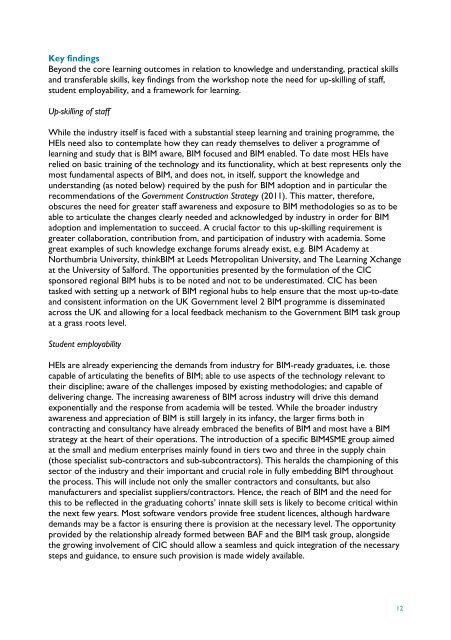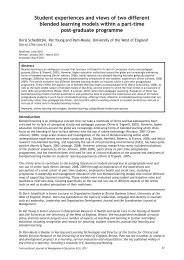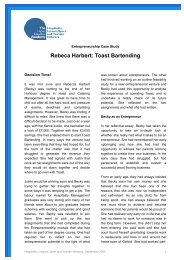Embedding Building Information Modelling (BIM) within the taught ...
Embedding Building Information Modelling (BIM) within the taught ...
Embedding Building Information Modelling (BIM) within the taught ...
You also want an ePaper? Increase the reach of your titles
YUMPU automatically turns print PDFs into web optimized ePapers that Google loves.
Key findings<br />
Beyond <strong>the</strong> core learning outcomes in relation to knowledge and understanding, practical skills<br />
and transferable skills, key findings from <strong>the</strong> workshop note <strong>the</strong> need for up-skilling of staff,<br />
student employability, and a framework for learning.<br />
Up-skilling of staff<br />
While <strong>the</strong> industry itself is faced with a substantial steep learning and training programme, <strong>the</strong><br />
HEIs need also to contemplate how <strong>the</strong>y can ready <strong>the</strong>mselves to deliver a programme of<br />
learning and study that is <strong>BIM</strong> aware, <strong>BIM</strong> focused and <strong>BIM</strong> enabled. To date most HEIs have<br />
relied on basic training of <strong>the</strong> technology and its functionality, which at best represents only <strong>the</strong><br />
most fundamental aspects of <strong>BIM</strong>, and does not, in itself, support <strong>the</strong> knowledge and<br />
understanding (as noted below) required by <strong>the</strong> push for <strong>BIM</strong> adoption and in particular <strong>the</strong><br />
recommendations of <strong>the</strong> Government Construction Strategy (2011). This matter, <strong>the</strong>refore,<br />
obscures <strong>the</strong> need for greater staff awareness and exposure to <strong>BIM</strong> methodologies so as to be<br />
able to articulate <strong>the</strong> changes clearly needed and acknowledged by industry in order for <strong>BIM</strong><br />
adoption and implementation to succeed. A crucial factor to this up-skilling requirement is<br />
greater collaboration, contribution from, and participation of industry with academia. Some<br />
great examples of such knowledge exchange forums already exist, e.g. <strong>BIM</strong> Academy at<br />
Northumbria University, think<strong>BIM</strong> at Leeds Metropolitan University, and The Learning Xchange<br />
at <strong>the</strong> University of Salford. The opportunities presented by <strong>the</strong> formulation of <strong>the</strong> CIC<br />
sponsored regional <strong>BIM</strong> hubs is to be noted and not to be underestimated. CIC has been<br />
tasked with setting up a network of <strong>BIM</strong> regional hubs to help ensure that <strong>the</strong> most up-to-date<br />
and consistent information on <strong>the</strong> UK Government level 2 <strong>BIM</strong> programme is disseminated<br />
across <strong>the</strong> UK and allowing for a local feedback mechanism to <strong>the</strong> Government <strong>BIM</strong> task group<br />
at a grass roots level.<br />
Student employability<br />
HEIs are already experiencing <strong>the</strong> demands from industry for <strong>BIM</strong>-ready graduates, i.e. those<br />
capable of articulating <strong>the</strong> benefits of <strong>BIM</strong>; able to use aspects of <strong>the</strong> technology relevant to<br />
<strong>the</strong>ir discipline; aware of <strong>the</strong> challenges imposed by existing methodologies; and capable of<br />
delivering change. The increasing awareness of <strong>BIM</strong> across industry will drive this demand<br />
exponentially and <strong>the</strong> response from academia will be tested. While <strong>the</strong> broader industry<br />
awareness and appreciation of <strong>BIM</strong> is still largely in its infancy, <strong>the</strong> larger firms both in<br />
contracting and consultancy have already embraced <strong>the</strong> benefits of <strong>BIM</strong> and most have a <strong>BIM</strong><br />
strategy at <strong>the</strong> heart of <strong>the</strong>ir operations. The introduction of a specific <strong>BIM</strong>4SME group aimed<br />
at <strong>the</strong> small and medium enterprises mainly found in tiers two and three in <strong>the</strong> supply chain<br />
(those specialist sub-contractors and sub-subcontractors). This heralds <strong>the</strong> championing of this<br />
sector of <strong>the</strong> industry and <strong>the</strong>ir important and crucial role in fully embedding <strong>BIM</strong> throughout<br />
<strong>the</strong> process. This will include not only <strong>the</strong> smaller contractors and consultants, but also<br />
manufacturers and specialist suppliers/contractors. Hence, <strong>the</strong> reach of <strong>BIM</strong> and <strong>the</strong> need for<br />
this to be reflected in <strong>the</strong> graduating cohorts’ innate skill sets is likely to become critical <strong>within</strong><br />
<strong>the</strong> next few years. Most software vendors provide free student licences, although hardware<br />
demands may be a factor is ensuring <strong>the</strong>re is provision at <strong>the</strong> necessary level. The opportunity<br />
provided by <strong>the</strong> relationship already formed between BAF and <strong>the</strong> <strong>BIM</strong> task group, alongside<br />
<strong>the</strong> growing involvement of CIC should allow a seamless and quick integration of <strong>the</strong> necessary<br />
steps and guidance, to ensure such provision is made widely available.<br />
12
















